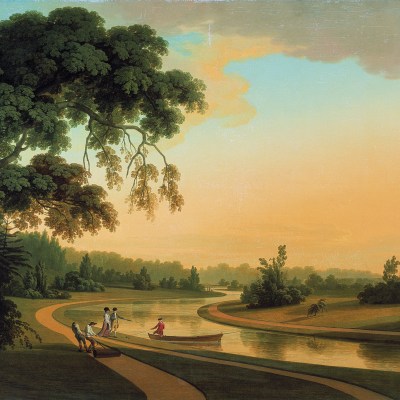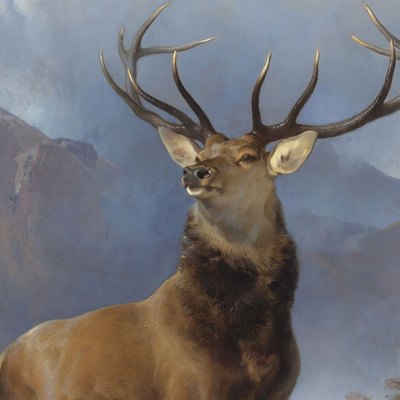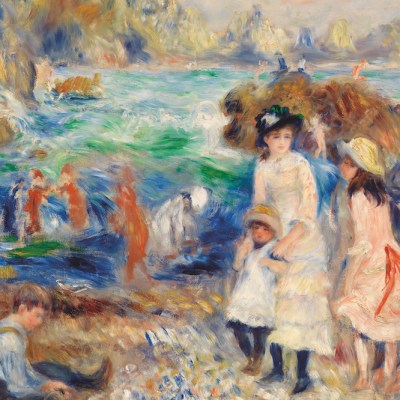From the December 2023 issue of Apollo. Preview and subscribe here.
As a young man in Glasgow, John Lavery spent three years apprenticed to a photographer. This major exhibition, which brings together more than 70 of his paintings, focuses on the artist’s on-the-spot capturing of the fleeting moment, not least as an artist-traveller. Ranging from Scotland to California, Lavery’s work is portrayed as grasping the sight and the spirit of the people and places of the passing scene. The tinting and retouching of photographs he pursued in his youth, though, might give pause as to quite what kind of reality he discovered in his work.
The opening room brings together canvases depicting the environs of Grez-sur-Loing, south of Paris on the edge of the Forest of Fontainebleau. Lavery first went to the village in the summer of 1883, near the start of his career, and began working immediately on The Bridge at Grez (1883). It depicts a simple scene. A man out sculling looks across the river at two women in a rowing boat, one looking back at him. The river is framed by the far bank behind and the bridge to one side, from which two spectators look back upon the river. Part of what lifts it above a humdrum genre painting of modern leisure is the way in which its unusual panoramic format, underlined by the long, thin foregrounded scull, accentuates a sense of the water’s horizontal flow. Cutting across such implied movement are also the vertical reflections running down across the river. The painted surface of the canvas is made up of flat, opaque patches of pigment which coalesce into longer lines and bands. Both in terms of the field of the picture, and its means of representation, there are several things happening at once.
Grez was already an established artists’ colony and Lavery went there on the trail of the cosmopolitan followers of the rural naturalism of Jules Bastien-Lepage. The exhibition catalogue suggests he was attempting to match the scale and ambition of William Stott of Oldham’s The Ferry (1881), a success at the previous year’s Salon. Painting the ancient bridge from the garden of the Hôtel Chevillon, Lavery was working where others had already worked. The following summer, in On the Bridge at Grez (1884), Lavery posed his fellow painter Frank O’Meara alongside the portable equipment of his trade. Somewhat awkwardly, O’Meara looks at two women from the village also standing on the bridge, who are looking away out to the water. Lavery was not so much moving towards naturalism as painting its sometimes somewhat uneasy staging.
On the Bridge at Grez (1884), John Lavery. National Gallery of Ireland, Dublin
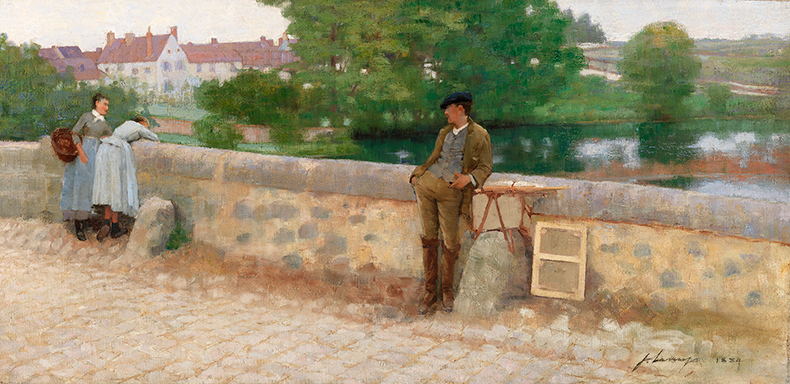
Later in 1884, he moved back to Glasgow. There he chronicled the craze of lawn tennis in the city’s opulent suburbs. In Played (1885), a loose small oil sketch, the momentary drama is of a young woman’s on-court lunge towards the ball – but her blue-hatted and pink-jacketed opponent in this dance on grass might have wandered in from a fête galante by Watteau. At the Glasgow International Exhibition in 1888, Lavery painted more than 50 small impressions in situ. The exhibition stresses the skill he displays in these as an artist-reporter, capable of quickly recording any circumstance. As striking, though, are their adroit trapping of the occasion’s contrived incongruity. A Venetian gondola glides on the canalised river Kelvin in front of an Orientalist industrial exhibition hall; a crowd gathers at a bandstand to hear a Hungarian gypsy string band, while behind looms an onion-domed mock Raj bungalow; women sit sipping cocoa in a full-scale replica of a 17th-century Dutch merchant’s house.
The year of 1888 was a breakthrough one for the painter: a gold medal at the Salon for another tennis painting was soon followed by a large commission to paint the reception held when Queen Victoria visited the International Exhibition. The exhibition does not quite find a convincing path through the considerable and distinctly worldly levels of success that followed. Neither does it engage with the dangers as well as the advantages of Lavery’s remarkable facility. In the long career that followed, amid a busy practice as a leading society portraitist and the sometimes rather low-powered finger exercises of a wealthy artist keen on travel, some kind of technical challenge or the pressure of history’s quickening often seemed to have been necessary to provoke Lavery’s best work.
Evening, Tangiers (1906), John Lavery. Courtesy Birmingham Museums Trust on behalf of Birmingham City
Council
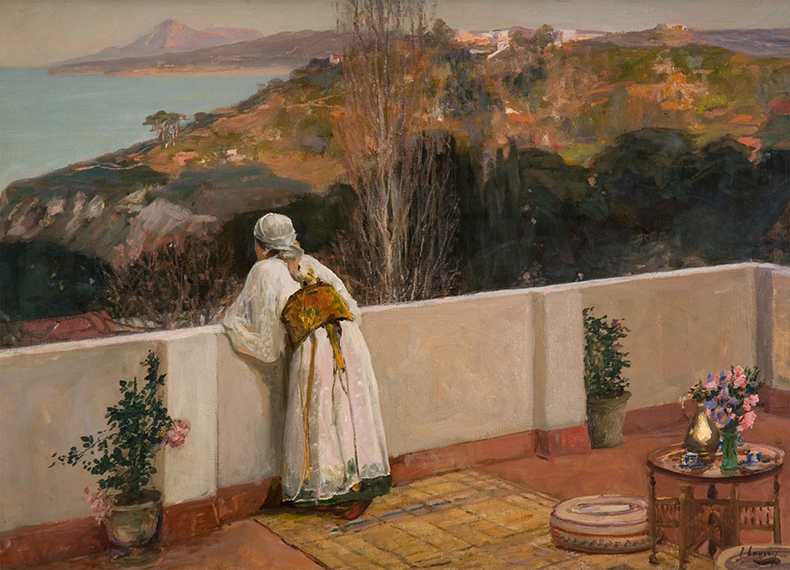
From the 1890s, for instance, he spent significant periods of time in Tangier. The exhibition devotes a whole room to the paintings he produced in this location. An attempt is made to pitch the results of his early on-the-spot studies there, such as The Snake Charmers (1891), as standing in muted, realist contrast to other Orientalist painters. Something is also made of the adventuring romance of Lavery’s later excursions inland to Fez. But a convincing vein of North African paintings never appears to materialise. By the late 1900s and early 1910s, having by then bought a house and studio in Tangier, the garden scenes and seascapes collected here constitute something of an evasive gaze away from local unrest.
A Coast Defence: an 18-Pounder Anti-Aircraft Gun, Tyneside (1917), John Lavery. Imperial War Museum, London. Photo: © IWM Art.IWM ART 1263
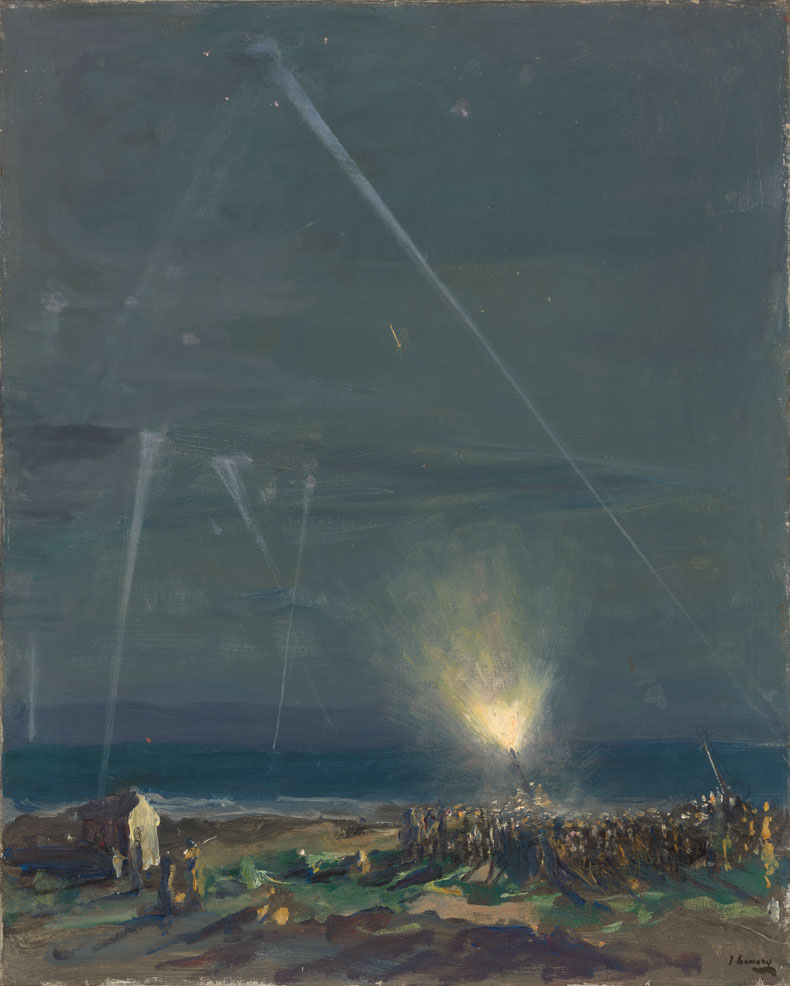
Altogether more successful are the few pictures gathered here from Lavery’s work as a war artist. A Coast Defence: an 18-Pounder Anti-Aircraft Gun, Tyneside (1917) arrestingly records searchlights and explosions within a dark night-time sky, depicted in complex tones. The novel lines of submarines in the water and the endlessly stretching rows of graves are registered no less memorably. However, the power of these paintings is somewhat diluted among a decidedly mixed and uneven last portion of the exhibition. Sitting either side of them are a ragbag of paintings drawn from Lavery’s travels before and after the war, through Spain, Italy, France, Switzerland, Scotland, Ireland and the United States. From the jockeys’ dazzling silks in their Ascot dressing room to the fervent devotions of besuited Dublin pilgrims kneeling in prayer on a flagstone shoreline in County Donegal, the best of these again grasp a curiously staged reality. Lavery might be on location, before his collapsible easel, but his subjects already seem to be living on a studio set.
‘Lavery. On Location’ is at the National Gallery of Ireland, Dublin, until 14 January 2024.
From the December 2023 issue of Apollo. Preview and subscribe here.

